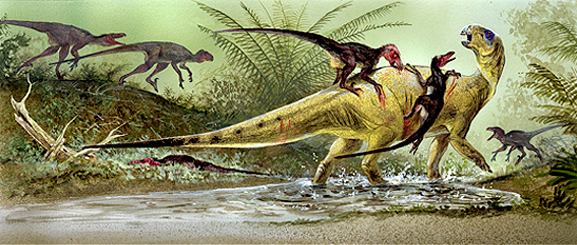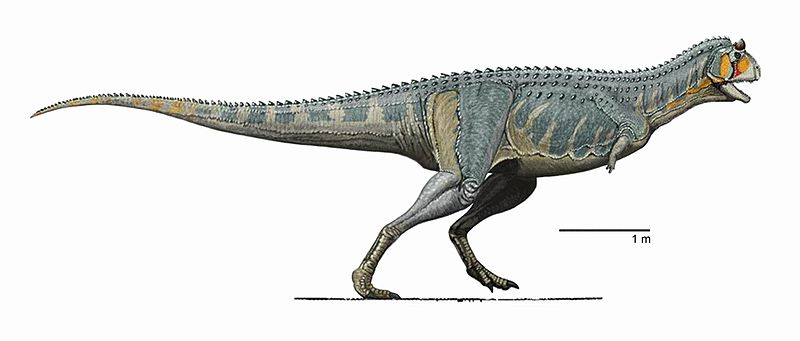Deinonychus antirrhopus (pack of 8) vs. Carnotaurus sastrei
Jun 19, 2019 17:31:36 GMT 5
rock likes this
Post by dinosauria101 on Jun 19, 2019 17:31:36 GMT 5
Deinonychus antirrhopus (pack of 8)
Based on the few fully mature specimens, Deinonychus could reach 4 metres (13 ft) in length, with a a weight of 111 kg (244 lb). Its skull was equipped with powerful jaws lined with around sixty curved, blade-like teeth. Studies of the skull have progressed a great deal over the decades. Ostrom reconstructed the partial, imperfectly preserved, skulls that he had as triangular, broad, and fairly similar to Allosaurus. Additional Deinonychus skull material and closely related species found with good 3D preservation show that the palate was more vaulted than Ostrom thought, making the snout far narrower, while the jugals flared broadly, giving greater stereoscopic vision. The skull of Deinonychus was different from that of Velociraptor, however, in that it had a more robust skull roof like that of Dromaeosaurus, and did not have the depressed nasals of Velociraptor. Both the skull and the lower jaw had fenestrae (skull openings) which reduced the weight of the skull. In Deinonychus, the antorbital fenestra, a skull opening between the eye and nostril, was particularly large.

Carnotaurus sastrei
Carnotaurus is a genus of large theropod dinosaur that lived in South America during the Late Cretaceous period, between about 72 and 70 million years ago. The only species is Carnotaurus sastrei. Known from a single well-preserved skeleton, it is one of the best-understood theropods from the Southern Hemisphere. The skeleton, found in 1984, was uncovered in the Chubut Province of Argentina from rocks of the La Colonia Formation. Derived from the Latin carno [carnis] ("flesh") and taurus ("bull"), the name Carnotaurus means "meat-eating bull", alluding to its bull-like horns. Carnotaurus is a derived member of the Abelisauridae, a group of large theropods that lived in the southern Landmasses of Gondwana during the late Cretaceous. Carnotaurus was a lightly built, bipedal predator, measuring 9 metres (30 ft) in length and perhaps weighing in a region of 2 tons. As a theropod, Carnotaurus was highly specialized and distinctive. It had thick horns above the eyes, a feature unseen in all other carnivorous dinosaurs, and a very deep skull sitting on a muscular neck. Carnotaurus was further characterized by small, vestigial forelimbs and long and slender hindlimbs. The skeleton is preserved with extensive skin impressions, showing a mosaic of small, non-overlapping scales measuring approximately 5 mm in diameter. The mosaic was interrupted by large bumps that lined the sides of the animal, and there are no hints of feathers. Carnotaurus was well adapted for running and was possibly one of the fastest large theropods.

Credit to Wikipedia
Based on the few fully mature specimens, Deinonychus could reach 4 metres (13 ft) in length, with a a weight of 111 kg (244 lb). Its skull was equipped with powerful jaws lined with around sixty curved, blade-like teeth. Studies of the skull have progressed a great deal over the decades. Ostrom reconstructed the partial, imperfectly preserved, skulls that he had as triangular, broad, and fairly similar to Allosaurus. Additional Deinonychus skull material and closely related species found with good 3D preservation show that the palate was more vaulted than Ostrom thought, making the snout far narrower, while the jugals flared broadly, giving greater stereoscopic vision. The skull of Deinonychus was different from that of Velociraptor, however, in that it had a more robust skull roof like that of Dromaeosaurus, and did not have the depressed nasals of Velociraptor. Both the skull and the lower jaw had fenestrae (skull openings) which reduced the weight of the skull. In Deinonychus, the antorbital fenestra, a skull opening between the eye and nostril, was particularly large.

Carnotaurus sastrei
Carnotaurus is a genus of large theropod dinosaur that lived in South America during the Late Cretaceous period, between about 72 and 70 million years ago. The only species is Carnotaurus sastrei. Known from a single well-preserved skeleton, it is one of the best-understood theropods from the Southern Hemisphere. The skeleton, found in 1984, was uncovered in the Chubut Province of Argentina from rocks of the La Colonia Formation. Derived from the Latin carno [carnis] ("flesh") and taurus ("bull"), the name Carnotaurus means "meat-eating bull", alluding to its bull-like horns. Carnotaurus is a derived member of the Abelisauridae, a group of large theropods that lived in the southern Landmasses of Gondwana during the late Cretaceous. Carnotaurus was a lightly built, bipedal predator, measuring 9 metres (30 ft) in length and perhaps weighing in a region of 2 tons. As a theropod, Carnotaurus was highly specialized and distinctive. It had thick horns above the eyes, a feature unseen in all other carnivorous dinosaurs, and a very deep skull sitting on a muscular neck. Carnotaurus was further characterized by small, vestigial forelimbs and long and slender hindlimbs. The skeleton is preserved with extensive skin impressions, showing a mosaic of small, non-overlapping scales measuring approximately 5 mm in diameter. The mosaic was interrupted by large bumps that lined the sides of the animal, and there are no hints of feathers. Carnotaurus was well adapted for running and was possibly one of the fastest large theropods.

Credit to Wikipedia






